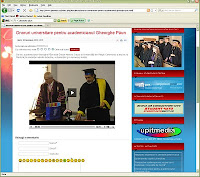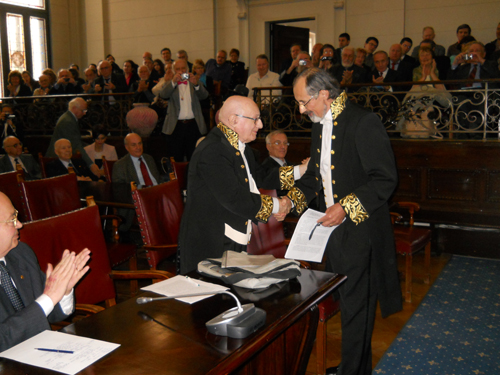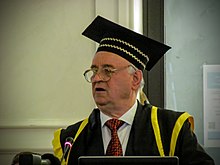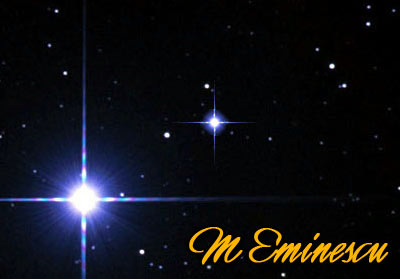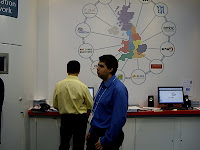Once on a time, as poets sing
High tales with fancy laden,
Born of a very noble king
There lived a wondrous maiden.
An only child, her kinsfolk boon,
So fair, imagination faints;
As though amidst the stars the moon,
Or Mary amidst the saints
From 'neath the castle's dark retreat,
Her silent way she wended
Each evening to the window-seat
Where Lucifer attended.
And secretly, with never fail,
She watched his double race,
Where vessels drew their pathless trail
Across the ocean's face.
And as intent she drank his light,
Desire was quickly there;
While he who saw her every night
Soon fell in love with her.
And sitting thus with rested head,
Her elbows on the sill,
Her heart by youthful fancy led
Did with deep longing fill.
While he, a brilliant shining spark,
Glowed always yet more clear
Towards the castle tall and dark
Where she would soon appear
...
Until one night with shower of rays
He slips into her room,
As though a strange and silver haze
Did round about her loom.
And when at last the child to rest
Upon her sofa lies,
He lays her arms across her breast
And closes her soft eyes.
While where his ray on mirror lands
And is upon her couch red rifted,
It falls upon her throat and hands
And on her face uplifted.
A smile is on her lips it seems;
He in the mirror trembles,
For smooth his ray glides midst her dreams
And round her soul assembles.
And while she is in slumber gone
She murmurs through her sighs:
"Come down to me beloved one,
Fair prince of the clear skies.
Come down, good Lucifer and kind,
O lord of my aspire,
And flood my chamber and my mind
With your sweetest fire !"
And Lucifer beams still more bright
To hear her word's emotion;
Then like a comet in its flight
Dives down into the ocean.
And where his bolt is lost to view
The sea in whirlpool surges,
Till out of the unfathomed blue
A handsome youth emerges,
Who, leaping off the fretful wave,
Lightly through her casement passes;
And in his hand he holds a stave
Crowned with a wreath of grasses.
A prince indeed of royal stock,
With heavy hanging golden hair;
A purple winding-sheet his smock,
Hung round his shoulders bare.
A starry glow shines from his eyes,
His cheeks are deathly white;
A lifeless thing in living guise,
A youth born of the night.
"Down from the spheres do I come
Though dreadful the commotion,
My father is the vaulted dome,
My mother is the ocean.
For I have left my realm to keep
Obedience to your command;
Born of the zenith and the deep
Here I before you stand.
O come, fair child of royal birth,
Cast this your world aside,
For Lucifer has flown to earth
To claim you as his bride.
And you will live till time is done
In castles built of sky,
And all the fish will be your own,
And all the birds that fly".
"O, beautiful you are, good Sire,
As but an angel prince could be,
But to the course that you desire
I never shall agree
Strange, as your voice and vesture show,
I live while you are dead;
Your eyes gleam with an icy glow
Which fills my soul with dread."
One day went past, and went past-two,
Then o'er the castle dark,
Fair Lucifer again to view
Shone forth his lustrous spark.
And scarce his beam waved bright above,
Her dreams to him were borne,
Her heart again by aching love
And cruel longing torn.
"Come down, good Lucifer and kind,
O lord of my aspire,
And flood my chamber and my mind
With your sweetest fire !"
Now, as he heard her tender cry
With pain he faded out,
And lightning flew about the sky,
Which wheeled and rocked about;
Around the earth a lurid glow
Poured like a torrent race,
Till out of its chaotic flow
There grew a human face;
About the head dark wisps of hair
Girt with a crown of flame,
And through the sun-illumined air
Borne up by truth he came.
His arms of rounded marble sheen
Did 'neath a cloak of raven show,
And sad and thoughtful was his mien
And pallid was his brow.
Bright eyes he had that seemed to tell
Of strange chimerical bonds;
And deep they were as passion's spell,
And dark as moonlit ponds.
"Down from the spheres have I flown,
Though terrible my flight;
My father wears Apollo's crown,
My mother is the night.
O come, fair child of royal birth,
Cast this your world aside,
For Lucifer has flown to earth
To claim you as his bride.
A starry halo from the skies
About your hair will fall,
And you among the spheres will rise
The proudest of them all."
"O, beautiful you are, good Sire,
As but a demon prince could be,
But to the course of your desire
I never shall agree.
You wound me with your crude behest;
I dread what you extol;
Your heavy eyes, as though possessed,
Gleam down into my soul."
"But why should I descend to thee?
Far better what I give;
My days are all eternity,
While you but one hour live."
"I would not chosen phrases seek,
Nor carefully my words arrange,
But though with human mouth you speak,
Your speech to me is strange.
Yet if you wish to prove your worth,
That I betroth myself to you,
Well, then come down to me on earth
And be a mortal too."
You ask my endless, life above
To barter for a kiss.
Aye, I will show how my love,
How deep my longing is.
My birthright I will fling aside
To be reborn of sin, and I
Who to all rolling time am tied,
Will that great knot untie."
At which he turned and went away
Midst a cloud of sombre pearl,
To renounce his birthright from that day
For the love of a mortal girl.
...
About this time young Catalin
Was a page boy of that house,
Who filled the festive cups with wine
At feast and royal carouse.
And carried high the regal train;
A foundling, brought by chance,
Born of a humble unknown strain,
Though roguish in his glance,
Round-cheeked, like rose-apples red,
Mischievous, bright-eyed,
A slipped with quick yet stealthy tread
To Catalina's side.
Upon my soul, Queen of romance !
Was such a darling ever?
Come Catalin, quick try your chance,
For now's your time or never.
At which he round her waist did twine
His arm in sudden wooing.
"Behave, you rascal Catalin,
Whatever are you doing?"
"By sorrow brooding all the while
You would your heart assuage,
But better you would turn and smile
And kiss just once your page."
"I know not what your wishes are,
Leave me alone, you knave.
Ah me ! The longing for that star
Will drive me to the grave."
"If you don't know, and you would learn
How love is set about,
Don't recklessly my teaching spurn,
First fairly hear me out.
As trappers deftly birds pursue
With nets among the tree,
When I stretch out my arm to you,
Slip your arm thus round me.
Your eyes into my eyes must glow,
Nor turn away, nor close
And when I lift you softly, so,
Rise gently on your toes.
And when my face is downwards bent
Your face turned up will stay,
That we may gaze with sweet intent
For ever and a day.
While should you wish at last to learn
The measure of love's bliss,
When hot my lips on yours do burn
Give back again my kiss."
Amused, yet with a girl's surprise
At what the youth acclaimed,
She blushed and turned away her eyes,
Half willing, half ashamed.
"A chatterbox you were since small
With overmuch to tell,
Yet I had felt, in spite of all,
We'd suit each other well".
But Lucifer's slow sailing spark
Crept up out of the sea
Over the horizon's arc,
Prince of eternity.
And now my wretched heart does bleed,
With tears my eyes grow dim,
When e'er I watch the waves that speed
Across the sea to him.
While he looms with adoring ray
My grief to overthrow,
Yet ever climbs to heights away
Where mortals cannot go.
His silver beams that space defy
Sadly my watchers are
And I shall love him till I die,
Yet he be ever far.
And thus it is the days to me
Are drear as desert sand,
The nights filled with a mystery
I dare not understand..."
"How childish is the way you speak.
Come on ! Come, lets run away,
That all the world for us shall seek
Though no one finds the way.
And we shall nothing of this life regret
But joyous live and sprightly,
Till soon your parents you'll forget,
Nor dream your longings nightly."
*
*
*
*
Lucifer set out and o'er
The sky his wings extended,
And million years flew past before
As many moments ended.
A sky of stars above his way,
A sky of stars below;
As lightning flash midst them astray
In one continuous flow.
Till round his primal chaos hurled
When out of causeless night
The first, up flaming dawn unfurled
Its miracle of light.
Still further flew he ere the start
Of things of form devoid,
Spurred by the yearning of his heart,
Far back into the void.
Yet where he reach's is not the bourn
Nor yet where eye can see;
Beyond where struggling time was torn
Out of eternity.
Around him there was naught. And still,
Strange yearning there was yet,
A yearning that all space did fill,
As when the blind forget.
"O, Father God, this knot untie
Of my celestial birth,
And praised you will be on high
And on the rolling earth.
The price you ask is little count,
Give fate another course,
For you are of fair life the fount
And of calm death the source.
Take back this halo from my head,
Take back my starry lower,
And give to me, o God, instead
Of human love one hour.
Out of the chaos was I wrought,
In chaos would I be dispersed,
Out of the empty darkness brought,
For darkness do I thirst..."
"Hyperion, o child divine,
Don't thus your state disclaim,
Nor ask for miracle, nor sign
That has nor sense nor name.
You wish to be a man of son,
To be a star you scorn;
But men quick perish every one,
And men each day are born.
Yet stars burn on with even glow,
And it is fate's intending
That they nor time, nor place shall know,
Unfettered and unending.
Out of eternal yesterday
Into tomorrow's grave,
Even the sun will pass way
That other sun's shall lave;
The sun that every morn does rise
At last it's spirit gives,
For each thing lives because it dies,
And dies because it lives.
But you, Hyperion, never wane,
Night's miracle sublime,
But in the sky your place retain,
The wonder of all time.
So what strange fancy holds your mind
What dreaming thus berates you?
Return to earth and there you'll find
The awakening that awaits you."
...
Hyperion did straightway go
To where through ages gone
His gleam upon the earth below
Nightly he had shone.
And it was evening when he came,
Night's darkness slow assembled,
And rose the moon a frozen flame
That in the water trembled,
And filled the forest's twilight clime
With a silver starry mist,
Where 'neath a tall and spreading lime
Two fair-haired children kissed.
"O, let me lay in lover's wise
My head upon your breast,
Beneath the wonder of your eyes,
In soft and fragrant rest.
In mystery's enchanted light
Pervade me with your charm,
And flood my soul through passion's night
With time's eternal calm.
O, quench my longing's eager thirst,
My aching doubts overcast,
For you to me are love the first,
And of my dreams the last."
Hyperion gazed down and knew
The fire their souls possessed;
For scarce the boy her nearer drew,
She clasped him to her breast.
A rain of petals in the air
That softly did enfold
Two fervent children strangely fair,
With locks of plated gold.
She, lost in love's enraptured flight,
To heaven turned her eyes,
Saw Lucifer's down shining light
And whispered through her sighs:
"Come down, good Lucifer and kind,
O lord of my aspire.
And fill the forest and my mind
With your sweetest fire !"
And Lucifer, alone in space,
Her tender summons heard,
A planet o'er the ocean's face
That trembled at her word,
But did not plunge as in former day,
And in his heart did cry:
"O, what care you, fair face of clay,
If it be he or I?
Still earth shall only earth remain,
Let luck its course unfold,
And I in my own kingdom reign
Immutable and cold."
|
A fost odata ca-n povesti,
A fost ca niciodata,
Din rude mari imparatesti,
O prea frumoasa fata.
Si era una la parinti
Si mindra-n toate cele,
Cum e Fecioara intre sfinti
Si luna intre stele.
Din umbra falnicelor bolti
Ea pasul si-l indreapta
Linga fereastra, unde-n colt
Luceafarul asteapta.
Privea in zare cum pe mari
Rasare si straluce,
Pe miscatoarele carari
Corabii negre duce.
Il vede azi, il vede mini,
Astfel dorinta-i gata;
El iar, privind de saptamini,
Ii cade draga fata.
Cum ea pe coate-si razima
Visind ale ei timple
De dorul lui si inima
Si sufletu-i se imple.
Si cit de viu s-aprinde el
In orisicare sara,
Spre umbra negrului castel
Cind ea o sa-i apara.
Si pas cu pas pe urma ei
Aluneca-n odaie,
Tesind cu recile-i scintei
O mreaja de vapaie.
Si cind in pat se-ntinde drept
Copila sa se culce,
I-atinge miinile pe piept,
I-nchide geana dulce;
Si din oglinda luminis
Pe trupu-i se revarsa,
Pe ochii mari, batind inchisi
Pe fata ei intoarsa.
Ea il privea cu un suris,
El tremura-n oglinda,
Caci o urma adinc in vis
De suflet sa se prinda.
Iar ea vorbind cu el in somn,
Oftind din greu suspina:
- "O, dulce-al noptii mele domn,
De ce nu vii tu? Vina!
Cobori in jos, luceafar blind,
Alunecind pe-o raza,
Patrunde-n casa si in gind
Si viata-mi lumineaza!"
El asculta tremurator,
Se aprindea mai tare
Si s-arunca fulgerator,
Se cufunda in mare;
Si apa unde-au fost cazut
In cercuri se roteste,
Si din adinc necunoscut
Un mindru tinar creste.
Usor el trece ca pe prag
Pe marginea ferestrei
Si tine-n mina un toiag
Incununat cu trestii.
Parea un tinar voievod
Cu par de aur moale,
Un vinat giulgi se-ncheie nod
Pe umerele goale.
Iar umbra fetei stravezii
E alba ca de ceara -
Un mort frumos cu ochii vii
Ce scinteie-n afara.
- "Din sfera mea venii cu greu
Ca sa-ti urmez chemarea,
Iar cerul este tatal meu
Si muma-mea e marea.
Ca in camara ta sa vin,
Sa te privesc de-aproape,
Am coborit cu-al meu senin
Si m-am nascut din ape.
O, vin'! odorul meu nespus,
Si lumea ta o lasa;
Eu sunt luceafarul de sus,
Iar tu sa-mi fii mireasa.
Colo-n palate de margean
Te-oi duce veacuri multe,
Si toata lumea-n ocean
De tine o s-asculte."
- "O, esti frumos, cum numa-n vis
Un inger se arata,
Dara pe calea ce-ai deschis
N-oi merge niciodata;
Strain la vorba si la port,
Lucesti fara de viata,
Caci eu sunt vie, tu esti mort,
Si ochiul tau ma-ngheata."
Trecu o zi, trecura trei
Si iarasi, noaptea, vine
Luceafarul deasupra ei
Cu razele-i senine.
Ea trebui de el in somn
Aminte sa-si aduca
Si dor de-al valurilor domn
De inim-o apuca:
- "Cobori in jos, luceafar blind,
Alunecind pe-o raza,
Patrunde-n casa si in gind
Si viata-mi lumineaza!"
Cum el din cer o auzi,
Se stinse cu durere,
Iar ceru-ncepe a roti
In locul unde piere;
In aer rumene vapai
Se-ntind pe lumea-ntreaga,
Si din a chaosului vai
Un mindru chip se-ncheaga;
Pe negre vitele-i de par
Coroana-i arde pare,
Venea plutind in adevar
Scaldat in foc de soare.
Din negru giulgi se desfasor
Marmoreele brate,
El vine trist si ginditor
Si palid e la fata;
Dar ochii mari si minunati
Lucesc adinc himeric,
Ca doua patimi fara sat
Si pline de-ntuneric.
- "Din sfera mea venii cu greu
Ca sa te-ascult s-acuma,
Si soarele e tatal meu,
Iar noaptea-mi este muma;
O, vin', odorul meu nespus,
Si lumea ta o lasa;
Eu sunt luceafarul de sus,
Iar tu sa-mi fii mireasa.
O, vin', in parul tau balai
S-anin cununi de stele,
Pe-a mele ceruri sa rasai
Mai mindra decit ele."
- "O, esti frumos cum numa-n vis
Un demon se arata,
Dara pe calea ce-ai deschis
N-oi merge niciodata!
Ma dor de crudul tau amor
A pieptului meu coarde,
Si ochii mari si grei ma dor,
Privirea ta ma arde."
- "Dar cum ai vrea sa ma cobor?
Au nu-ntelegi tu oare,
Cum ca eu sunt nemuritor,
Si tu esti muritoare?"
- "Nu caut vorbe pe ales,
Nici stiu cum as incepe -
Desi vorbesti pe inteles,
Eu nu te pot pricepe;
Dar daca vrei cu crezamint
Sa te-ndragesc pe tine,
Tu te coboara pe pamint,
Fii muritor ca mine."
- "Tu-mi cei chiar nemurirea mea
In schimb pe-o sarutare,
Dar voi sa stii asemenea
Cit te iubesc de tare;
Da, ma voi naste din pacat,
Primind o alta lege;
Cu vecinicia sunt legat,
Ci voi sa ma dezlege."
Si se tot duce... S-a tot dus.
De dragu-unei copile,
S-a rupt din locul lui de sus,
Pierind mai multe zile.
In vremea asta Catalin,
Viclean copil de casa,
Ce imple cupele cu vin
Mesenilor la masa,
Un paj ce poarta pas cu pas
A-mparatesii rochii,
Baiat din flori si de pripas,
Dar indraznet cu ochii,
Cu obrajei ca doi bujori
De rumeni, bata-i vina,
Se furiseaza pinditor
Privind la Catalina.
Dar ce frumoasa se facu
Si mindra, arz-o focul;
Ei Catalin, acu-i acu
Ca sa-ti incerci norocul.
Si-n treacat o cuprinse lin
Intr-un ungher degraba.
- "Da' ce vrei, mari Catalin?
Ia du-t' de-ti vei de treaba."
- "Ce voi? As vrea sa nu mai stai
Pe ginduri totdeuna,
Sa rizi mai bine si sa-mi dai
O gura, numai una."
- "Dar nici nu stiu macar ce-mi ceri,
Da-mi pace, fugi departe -
O, de luceafarul din cer
M-a prins un dor de moarte."
- "Daca nu stii, ti-as arata
Din bob in bob amorul,
Ci numai nu te minia,
Ci stai cu binisorul.
Cum vinatoru-ntinde-n cring
La pasarele latul,
Cind ti-oi intinde bratul sting
Sa ma cuprinzi cu bratul;
Si ochii tai nemiscatori
Sub ochii mei ramiie...
De te inalt de subtiori
Te-nalta din calciie;
Cind fata mea se pleaca-n jos,
In sus ramii cu fata,
Sa ne privim nesatios
Si dulce toata viata;
Si ca sa-ti fie pe deplin
Iubirea cunoscuta,
Cind sarutindu-te ma-nclin,
Tu iarasi ma saruta."
Ea-l asculta pe copilas
Uimita si distrasa,
Si rusinos si dragalas,
Mai nu vrea, mai se lasa,
Si-i zise-ncet: - "Inca de mic
Te cunosteam pe tine,
Si guraliv si de nimic,
Te-ai potrivi cu mine...
Dar un luceafar, rasarit
Din linistea uitarii,
Da orizon nemarginit
Singuratatii marii;
Si tainic genele le plec,
Caci mi le imple plinsul
Cind ale apei valuri trec
Calatorind spre dinsul;
Luceste c-un amor nespus,
Durerea sa-mi alunge,
Dar se inalta tot mai sus,
Ca sa nu-l pot ajunge.
Patrunde trist cu raze reci
Din lumea ce-l desparte...
In veci il voi iubi si-n veci
Va raminea departe...
De-aceea zilele imi sunt
Pustii ca niste stepe,
Dar noptile-s de-un farmec sfint
Ce-l nu mai pot pricepe."
- "Tu esti copila, asta e...
Hai s-om fugi in lume,
Doar ni s-or pierde urmele
Si nu ne-or sti de nume.
Caci amindoi vom fi cuminti,
Vom fi voiosi si teferi,
Vei pierde dorul de parinti
Si visul de luceferi."
Porni luceafarul. Cresteau
In cer a lui aripe,
Si cai de mii de ani treceau
In tot atitea clipe.
Un cer de stele dedesupt,
Deasupra-i cer de stele -
Parea un fulger nentrerupt
Ratacitor prin ele.
Si din a chaosului vai,
Jur imprejur de sine,
Vedea, ca-n ziua cea dentii,
Cum izvorau lumine;
Cum izvorind il inconjor
Ca niste mari, de-a-notul...
El zboara, gind purtat de dor,
Pin' piere totul, totul;
Caci unde-ajunge nu-i hotar,
Nici ochi spre a cunoaste,
Si vremea-ncearca in zadar
Din goluri a se naste.
Nu e nimic si totusi e
O sete care-l soarbe,
E un adinc asemene
Uitarii celei oarbe.
- "De greul negrei vecinicii,
Parinte, ma dezleaga
Si laudat pe veci sa fii
Pe-a lumii scara-ntreaga;
O, cere-mi, Doamne, orice pret,
Dar da-mi o alta soarte,
Caci tu izvor esti de vieti
Si datator de moarte;
Reia-mi al nemuririi nimb
Si focul din privire,
Si pentru toate da-mi in schimb
O ora de iubire...
Din chaos, Doamne,-am aparut
Si m-as intoarce-n chaos...
Si din repaos m-am nascut.
Mi-e sete de repaos."
- "Hyperion, ce din genuni
Rasai c-o-ntreaga lume,
Nu cere semne si minuni
Care n-au chip si nume;
Tu vrei un om sa te socoti,
Cu ei sa te asameni?
Dar piara oamenii cu toti,
S-ar naste iarasi oameni.
Ei numai doar dureaza-n vint
Deserte idealuri -
Cind valuri afla un mormint,
Rasar in urma valuri;
Ei doar au stele cu noroc
Si prigoniri de soarte,
Noi nu avem nici timp, nici loc,
Si nu cunoastem moarte.
Din sinul vecinicului ieri
Traieste azi ce moare,
Un soare de s-ar stinge-n cer
S-aprinde iarasi soare;
Parind pe veci a rasari,
Din urma moartea-l paste,
Caci toti se nasc spre a muri
Si mor spre a se naste.
Iar tu, Hyperion, ramii
Oriunde ai apune...
Cere-mi cuvintul meu dentii -
Sa-ti dau intelepciune?
Vrei sa dau glas acelei guri,
Ca dup-a ei cintare
Sa se ia muntii cu paduri
Si insulele-n mare?
Vrei poate-n fapta sa arati
Dreptate si tarie?
Ti-as da pamintul in bucati
Sa-l faci imparatie.
Iti dau catarg linga catarg,
Ostiri spre a strabate
Pamintu-n lung si marea-n larg,
Dar moartea nu se poate...
Si pentru cine vrei sa mori?
Intoarce-te, te-ndreapta
Spre-acel pamint ratacitor
Si vezi ce te asteapta."
In locul lui menit din cer
Hyperion se-ntoarse
Si, ca si-n ziua cea de ieri,
Lumina si-o revarsa.
Caci este sara-n asfintit
Si noaptea o sa-nceapa;
Rasare luna linistit
Si tremurind din apa.
Si imple cu-ale ei scintei
Cararile din cringuri.
Sub sirul lung de mindri tei
Sedeau doi tineri singuri:
- "O, lasa-mi capul meu pe sin,
Iubito, sa se culce
Sub raza ochiului senin
Si negrait de dulce;
Cu farmecul luminii reci
Gindirile strabate-mi,
Revarsa liniste de veci
Pe noaptea mea de patimi.
Si de asupra mea ramii
Durerea mea de-o curma,
Caci esti iubirea mea dentii
Si visul meu din urma."
Hyperion vedea de sus
Uimirea-n a lor fata;
Abia un brat pe git i-a pus
Si ea l-a prins in brate...
Miroase florile-argintii
Si cad, o dulce ploaie,
Pe crestetele-a doi copii
Cu plete lungi, balaie.
Ea, imbatata de amor,
Ridica ochii. Vede
Luceafarul. Si-ncetisor
Dorintele-i increde:
- "Cobori in jos, luceafar blind,
Alunecind pe-o raza,
Patrunde-n codru si in gind,
Norocu-mi lumineaza!"
El tremura ca alte dati
In codri si pe dealuri,
Calauzind singuratati
De miscatoare valuri;
Dar nu mai cade ca-n trecut
In mari din tot inaltul:
- "Ce-ti pasa tie, chip de lut,
Dac-oi fi eu sau altul?
Traind in cercul vostru strimt
Norocul va petrece,
Ci eu in lumea mea ma simt
Nemuritor si rece."
1883, 24 apr - 6 mai
Mihail Eminescu
|
 Update: 04.11.2014 - Dr. Gheorghe Păun, Membru al Academiei Române, Secţia Ştiinţa şi Tehnologia Informaţiei (2012)
Update: 04.11.2014 - Dr. Gheorghe Păun, Membru al Academiei Române, Secţia Ştiinţa şi Tehnologia Informaţiei (2012) - University of Sevilla, Spain, Research Group on Natural Computing
- University of Sevilla, Spain, Research Group on Natural Computing
